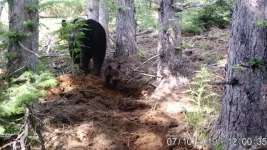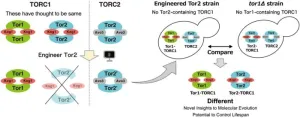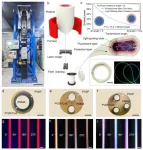(Press-News.org) Brown bears foraging for food in the Shiretoko Peninsula of Hokkaido, Japan, have been disrupting tree growth in artificial conifer forests, according to a new study. Researchers compared soil and tree samples from human-forested plots with samples from natural forests. They found that the bears’ digging for cicada nymphs damaged tree roots and altered the nitrogen content of the soil, which in turn limited the diameter growth of trees. The phenomena of bears digging for cicadas, an unusual food source, appears to be restricted to human-planted conifer forest; diversely vegetated natural forest was unaffected. Bears in Hokkaido sometimes suffer from sparse food supplies, but it is not known if this is the reason for their cicada search. These results are important for animal conservation and efforts to return used land to a wild state, highlighting the value of recreating diverse local ecosystems which can support natural wildlife behavior.
On the northeastern tip of Hokkaido, Japan’s northernmost main island, sits the Shiretoko Peninsula, and within it the Shiretoko National Park. Designated a World Nature Heritage site, thanks to its thriving ecosystem and diverse wildlife, the peninsula is home to Japan’s largest land animal, the brown bear. It is estimated that almost 500 bears live within the 70-kilometer-long and 25-km-wide strip, making it one of the highest densities of brown-bear populations in the world. Bear numbers in Hokkaido have been gradually recovering since the 1990s, when conservation efforts began in earnest after decades of unchecked culling.
Rather than being an isolated wilderness, thousands of people live and work in the Shiretoko Peninsula, and it is also a popular tourist destination. Since the 1970s, residents and local government have been planting conifers, such as larch and spruce, on abandoned farmland as a way to help return the area to its original forested state. However, this effort has led to some unusual behavior from the other larger inhabitants. Assistant Professor Kanji Tomita from Kochi University and Professor Tsutom Hiura from the University of Tokyo have been studying how brown bears interact with these human-made forests and found that the bears behave differently than when in their natural woodland.
“In our latest study, we found that brown bears have been negatively impacting the growth of replanted larch conifer trees. They come to the new forests to dig for cicada nymphs, a behavior we haven’t seen in natural woodland or heard reported elsewhere in the world,” said Hiura from the Graduate School of Agricultural and Life Sciences. “While mammalian digging behavior in natural ecosystems has typically been seen as having a positive influence, our research shows that the outcome is different in anthropogenic (human-made) landscapes.”
This latest research is a follow-up to a previous study by Tomita and Hiura, in which they first discovered the bears’ penchant for cicada nymphs. The pair were surprised that the bears dug for the cicadas exclusively in human-made conifer forest, not in natural woodland, and noticed the damage being done to the roots of the trees in the process. So, they decided to assess the impact of the bears’ behavior on the artificial forest’s ecosystem.
The researchers compared soil samples, tree needles and tree core samples from dug and undug larch conifer forests in Shiretoko. Finding undug plantations was a challenge, so they had to collect samples from conifer forests which had an underlying layer of bamboo, which the bears avoided. They found that digging activity decreased the biomass of fine roots, soil water content and nitrogen availability. This resulted in the width, or radial growth, of the trees being less in dug forests than in the untouched forests.
“Previous studies have not considered the human impacts of forestation efforts because data were collected from natural ecosystems. So, this study is important for wildlife conservation and understanding the roles of large mammals in anthropogenic landscapes,” explained Tomita. “Referring to knowledge from only pristine ecosystems is not sufficient. To develop more appropriate management strategies for large carnivores, we need to further understand their ecosystem roles in human-made landscapes.”
“Rather than rely on artificial afforestation (converting land into forest) methods, this research highlights the necessity of introducing natural regeneration methods by seed dispersal from the surrounding area,” said Hiura. “This will not only restore ecosystems with high species diversity and rich interactions among animals and plants, but it will also be beneficial to human society in the long term.”
Bears in Shiretoko and other parts of Japan have recently struggled to find enough of their staple foods, such as salmon and nuts, to survive. Increased human development and portioning off of land, along with variable harvests due to climate change, have exacerbated their situation. This increases the risk of potentially dangerous encounters, for both people and bears, as they wander into more populated towns, campsites and fishing areas. Enriching the bears’ natural habitat and planning new forests based on ecological research will hopefully help bears and humans to coexist safely and thrive in this beautiful environment.
-----
Paper Title:
Kanji M. Tomita and Tsutom Hiura. Brown bear digging decreases tree growth: Implication for ecological role of top predators in anthropogenic landscapes. Ecology. DOI: 10.1002/ecy.4266.
Funding:
This research was partly supported by JSPS to T.H. (no. 21H05316).
Useful Links
Graduate School of Agricultural and Life Sciences: https://www.a.u-tokyo.ac.jp/english/
Forest Ecosystem Management Lab: http://www.fes.es.a.u-tokyo.ac.jp
Research Contact:
Professor Tsutom Hiura
Department of Ecosystem Studies
Graduate School of Agricultural and Life Sciences, The University of Tokyo
Yayoi 1-1-1, Bunkyo-ku, Tokyo 113-8657
Email: hiura@g.ecc.u-tokyo.ac.jp
Tel.: 03-5841-8207
Press contact:
Mrs. Nicola Burghall
Public Relations Group, The University of Tokyo,
7-3-1 Hongo, Bunkyo-ku, Tokyo 113-8654, Japan
press-releases.adm@gs.mail.u-tokyo.ac.jp
About the University of Tokyo
The University of Tokyo is Japan's leading university and one of the world's top research universities. The vast research output of some 6,000 researchers is published in the world's top journals across the arts and sciences. Our vibrant student body of around 15,000 undergraduate and 15,000 graduate students includes over 4,000 international students. Find out more at https://www.u-tokyo.ac.jp/en/ or follow us on X (formally Twitter) at @UTokyo_News_en.
END
Brown bears digging up artificial forests
Study at Shiretoko World Heritage site shows unexpected interaction between animals and human-planted trees
2024-03-01
ELSE PRESS RELEASES FROM THIS DATE:
Innovative domain-adaptive method enables 3D face reconstruction from single depth images
2024-03-01
Reconstructing a 3D face from visuals is crucial for digital face modeling and manipulation. Traditional methods predominantly depend on RGB images, which are susceptible to lighting variations and offer only 2D information. In contrast, depth images, resistant to lighting changes, directly capture 3D data, offering a potential solution for robust reconstructions. Recent studies have turned to deep learning for more robust reconstruction from depth data; however, the scarcity of real depth images with accurate 3D facial labels has hindered the training process. Attempts to use auto-synthesized data for training have met limitations ...
Groundbreaking study unveils unique roles of yeast protein complexes in cellular lifespan and environmental response by rationally engineering based on the predicted three-dimensional structures
2024-03-01
Assistant Professor Takahiro Kosugi of Institute for Molecular Science, assistant Professor Yoshiaki Kamada at National Institute for Basic Biology, and colleagues have developed an advanced molecular cell biology approach by integrating computational redesigning of protein complexes based on the predicted three-dimensional structure into yeast genetics. They revealed that two types of protein complexes in yeast, which were thought to have the same function, play distinct roles in cellular environmental response and lifespan. Furthermore, ...
Mass-produced, commercial promising multicolored photochromic fiber
2024-03-01
Fiber, as the wearable material with the longest application in the history of humankind, is currently an ideal substrate for wearable devices due to its excellent breathability, flexibility, and ability to adapt perfectly to the 3D irregular shape of the human body. As a means of visualization in the field of functional fibers, light-emitting fiber breaks the rigidity of the traditional display interface and is expected to become an emerging interaction interface. The current commercial light-emitting fibers are polymer optical fibers and Corning® Fibrance® light-diffusing fibers. These fibers ...
General Medical Council urged to revise terminology for international medical graduates
2024-03-01
The General Medical Council (GMC) should revise its terminology regarding international medical graduates (IMGs) in the UK, argues a new commentary published in the Journal of the Royal Society of Medicine (JRSM).
The existing terminology used by the GMC fails to encompass the full spectrum of doctors facing challenges in the UK medical workforce, according to the paper’s author, Professor Mo Al-Haddad of Queen Elizabeth University Hospital, Glasgow.
Notably, he says, the GMC's definition of IMGs overlooks ...
Prostate cancer test may lead to harmful overdiagnosis in black men
2024-03-01
A new study from experts at the University of Exeter has found that a widely used test for prostate cancer may leave black men at increased risk of overdiagnosis.
Prostate-specific antigen (PSA) testing is routinely used as the first step in the UK to investigate men with urinary symptoms such as blood in urine or urinating very frequently. Men aged over 50 years without symptoms are also able to request the blood test from their GP.
The new study, published in BMC Medicine, sought to investigate the performance of the PSA test in identifying prostate cancer among men ...
Discovery of proteins associated with the progression of dialysis-related amyloidosis
2024-03-01
Niigata, Japan –Dialysis patients often develop dialysis-related amyloidosis and exhibit bone and joint disorders that impair their activity of daily living (Figure 1). Blood purification devices consisting of hexadecyl-immobilized cellulose beads aimed at removing the precursor protein, β2- microglobulin (β2-m), are used in the treatment of dialysis-related amyloidosis. Dr. Yamamoto et al. investigated that comprehensive analysis of proteins adsorbed onto blood purification devices revealed the identification of 200 types of proteins, including β2-m. ...
Tiny magnetic particles in air pollution linked to development of Alzheimer’s
2024-03-01
Magnetite, a tiny particle found in air pollution, can induce signs and symptoms of Alzheimer’s disease, new research suggests.
Alzheimer’s disease, a type of dementia, leads to memory loss, cognitive decline, and a marked reduction in quality of life. It impacts millions globally and is a leading cause of death in older individuals.
The study, Neurodegenerative effects of air pollutant particles: Biological mechanisms implicated for early-onset Alzheimer’s disease, led by Associate Professor Cindy Gunawan and Associate Professor Kristine McGrath from the University of Technology Sydney (UTS) was recently published in Environment ...
Repurposed credit card-sized technology improves and broadens use of diagnostic stool tests
2024-03-01
A patient with gastrointestinal problems pays his doctor a visit. The doctor orders a stool test that will measure fecal bile acids, compounds made by the liver that can also be modified by the intestinal microbiome and are known for facilitating digestion and absorption of lipids or fats in the small intestine.
Bile acid profiles are altered in several gastrointestinal conditions, including irritable bowel syndrome, Crohn’s disease, and several forms of diarrhea, colitis and some bacterial ...
Loneliness increases the risk of health deterioration in older adults
2024-03-01
The loneliness often experienced by older people in our society has a negative effect on their physical health, according to researchers from Amsterdam UMC and the University of Glasgow. Emiel Hoogendijk, epidemiologist at Amsterdam Public Health, analysed research results from more than 130 studies and found that loneliness led to an increase in physical frailty, which in turn increases the risk of adverse health outcomes such as depression, falls and cognitive decline. These results are published today in The Lancet Healthy Longevity.
"Recently, ...
The Lancet: More than one billion people in the world are now living with obesity, global analysis suggests
2024-03-01
The Lancet: More than one billion people in the world are now living with obesity, global analysis suggests
Obesity rates among children and adolescents worldwide increased four times from 1990 to 2022, while obesity rates among adults have more than doubled.
Over the same period, rates of underweight fell among children, adolescents and adults, leading to obesity becoming the most common form of malnutrition in many countries.
Countries with the highest combined ...
LAST 30 PRESS RELEASES:
Archaeologists use AI to create prehistoric video game
Mitochondria migrate toward the cell membrane in response to high glucose levels
Tiny viral switch offers hope against drug-resistant bacteria
Most parents aware of early peanut introduction guidelines, but confused about details
HPV vaccine can protect against severe lesions of the vulva and vagina
Virtual care provision and emergency department use among children and youth
Quadrivalent HPV vaccine and high-grade vulvovaginal lesions
Insights into dry eyes gained from stem cell-derived tear glands
Researchers identify 166 human pluripotent stem cell lines available for use in clinical applications
Europa Clipper instrument uniquely observed interstellar comet 3I/ATLAS
UN University Report challenges climate change as sole trigger of Syrian Civil War, exposing governance failures in drought response
Real estate investment trust (REIT) acquisition associated with hospital closure and bankruptcy
New Raman imaging system detects subtle tumor signals
Boston Children’s receives a $7.5 million grant from Aligning Research to Impact Autism (ARIA) to provide clinical research coordination for the IMPACT Network
Spray-on antibacterial coating offers new protection for plants against disease and drought
ESMT Berlin study: What makes a first offer successful in negotiations
Groundbreaking ceremony marks the beginning of CTAO-South Array construction in Chile
Why swearing makes you stronger
What prevents more cancer patients from enrolling in potentially life-saving clinical trials?
UK’s worst-case climate risks laid bare for lawmakers
A decline in churchgoing linked to more deaths of despair
TAMEST announces Maralice Conacci-Sorrell, Ph.D., UT Southwestern Medical Center, as 2026 Mary Beth Maddox Award & Lectureship Recipient
Global study to evaluate whether dengue outbreaks can be anticipated earlier
Chonnam National University researchers propose innovative voltage-loop control for power factor correction
Accelerating next-generation drug discovery with click-based construction of PROTACs
Detecting the hidden magnetism of altermagnets
$7M gift supports health research, engineering and athletics at UT San Antonio
NU-9 halts Alzheimer’s disease in animal model before symptoms begin
Hospitals acquired by real estate investment trusts associated with greater risk of bankruptcy, closure
City of Hope scientists study rare disorder to uncover mechanism and hormone regulation underlying fatty liver disease and sweet aversion
[Press-News.org] Brown bears digging up artificial forestsStudy at Shiretoko World Heritage site shows unexpected interaction between animals and human-planted trees






